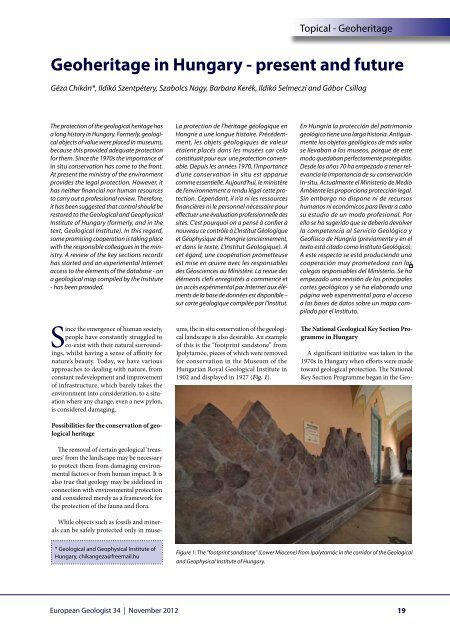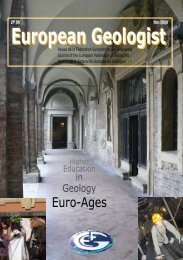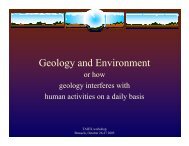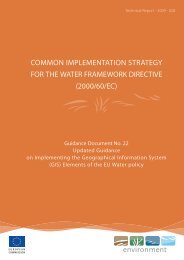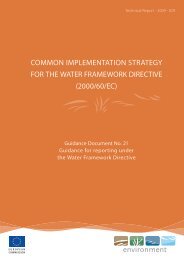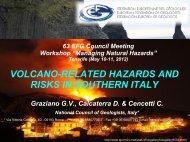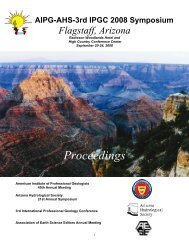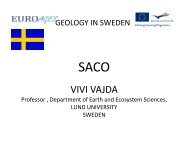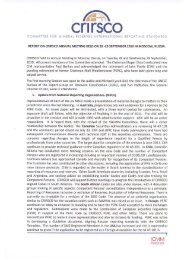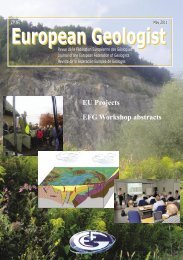European Geologist European Geologist Geoheritage - learning ...
European Geologist European Geologist Geoheritage - learning ...
European Geologist European Geologist Geoheritage - learning ...
Create successful ePaper yourself
Turn your PDF publications into a flip-book with our unique Google optimized e-Paper software.
Topical - <strong>Geoheritage</strong><br />
<strong>Geoheritage</strong> in Hungary - present and future<br />
Géza Chikán*, Ildikó Szentpétery, Szabolcs Nagy, Barbara Kerék, Ildikó Selmeczi and Gábor Csillag<br />
The protection of the geological heritage has<br />
a long history in Hungary. Formerly, geological<br />
objects of value were placed in museums,<br />
because this provided adequate protection<br />
for them. Since the 1970s the importance of<br />
in situ conservation has come to the front.<br />
At present the ministry of the environment<br />
provides the legal protection. However, it<br />
has neither financial nor human resources<br />
to carry out a professional review. Therefore,<br />
it has been suggested that control should be<br />
restored to the Geological and Geophysical<br />
Institute of Hungary (formerly, and in the<br />
text, Geological Institute). In this regard,<br />
some promising cooperation is taking place<br />
with the responsible colleagues in the ministry.<br />
A review of the key sections records<br />
has started and an experimental Internet<br />
access to the elements of the database - on<br />
a geological map compiled by the Institute<br />
- has been provided.<br />
Since the emergence of human society,<br />
people have constantly struggled to<br />
co-exist with their natural surroundings,<br />
whilst having a sense of affinity for<br />
nature’s beauty. Today, we have various<br />
approaches to dealing with nature, from<br />
constant redevelopment and improvement<br />
of infrastructure, which barely takes the<br />
environment into consideration, to a situation<br />
where any change, even a new pylon,<br />
is considered damaging.<br />
Possibilities for the conservation of geological<br />
heritage<br />
The removal of certain geological ‘treasures’<br />
from the landscape may be necessary<br />
to protect them from damaging environmental<br />
factors or from human impact. It is<br />
also true that geology may be sidelined in<br />
connection with environmental protection<br />
and considered merely as a framework for<br />
the protection of the fauna and flora.<br />
While objects such as fossils and minerals<br />
can be safely protected only in muse-<br />
La protection de l’héritage géologique en<br />
Hongrie a une longue histoire. Précédemment,<br />
les objets géologiques de valeur<br />
étaient placés dans les musées car cela<br />
constituait pour eux une protection convenable.<br />
Depuis les années 1970, l’importance<br />
d’une conservation in situ est apparue<br />
comme essentielle. Aujourd’hui, le ministère<br />
de l’environnement a rendu légal cette protection.<br />
Cependant, il n’a ni les ressources<br />
financières ni le personnel nécessaire pour<br />
effectuer une évaluation professionnelle des<br />
sites. C’est pourquoi on a pensé à confier à<br />
nouveau ce contrôle à L’Institut Géologique<br />
et Géophysique de Hongrie (anciennement,<br />
et dans le texte, L’Institut Géologique). A<br />
cet égard, une coopération prometteuse<br />
est mise en œuvre avec les responsables<br />
des Géosciences au Ministère. La revue des<br />
éléments clefs enregistrés a commencé et<br />
un accès expérimental par Internet aux éléments<br />
de la base de données est disponible –<br />
sur carte géologique compilée par l’Institut.<br />
ums, the in situ conservation of the geological<br />
landscape is also desirable. An example<br />
of this is the “footprint sandstone” from<br />
Ipolytarnóc, pieces of which were removed<br />
for conservation in the Museum of the<br />
Hungarian Royal Geological Institute in<br />
1902 and displayed in 1927 (Fig. 1).<br />
En Hungría la protección del patrimonio<br />
geológico tiene una larga historia. Antiguamente<br />
los objetos geológicos de más valor<br />
se llevaban a los museos, porque de este<br />
modo quedaban perfectamente protegidos.<br />
Desde los años 70 ha empezado a tener relevancia<br />
la importancia de su conservación<br />
in-situ. Actualmente el Ministerio de Medio<br />
Ambiente les proporciona protección legal.<br />
Sin embargo no dispone ni de recursos<br />
humanos ni económicos para llevar a cabo<br />
su estudio de un modo profesional. Por<br />
ello se ha sugerido que se debería devolver<br />
la competencia al Servicio Geológico y<br />
Geofísico de Hungría (previamente y en el<br />
texto está citado como Instituto Geológico).<br />
A este respecto se está produciendo una<br />
cooperación muy prometedora con los<br />
colegas responsables del Ministerio. Se ha<br />
empezado una revisión de los principales<br />
cortes geológicos y se ha elaborado una<br />
página web experimental para el acceso<br />
a las bases de datos sobre un mapa compilado<br />
por el Instituto.<br />
The National Geological Key Section Programme<br />
in Hungary<br />
A significant initiative was taken in the<br />
1970s in Hungary when efforts were made<br />
toward geological protection. The National<br />
Key Section Programme began in the Geo-<br />
* Geological and Geophysical Institute of<br />
Hungary, chikangeza@freemail.hu<br />
Figure 1: The “footprint sandstone” (Lower Miocene) from Ipolytarnóc in the corridor of the Geological<br />
and Geophysical Institute of Hungary.<br />
<strong>European</strong> <strong>Geologist</strong> 34 | November 2012<br />
19


